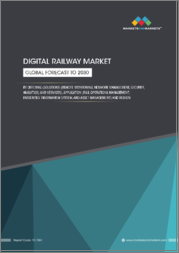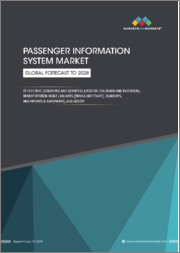
|
시장보고서
상품코드
1735653
승객 정보 시스템 시장 : 장소별, 교통수단별, 기능별, 제공별, 지역별(2026-2032년)Passenger Information System Market By Location (On-board and In-station), Transportation Mode (Railways, Roadways), Functional (Computing System, Video Surveillance), Offering (Solutions and Services), & Region for 2026-2032 |
||||||
승객 정보 시스템 시장 평가(2026-2032년)
비용 효율성을 중시하는 승객들의 더 나은 교통 경험에 대한 수요가 증가함에 따라 AI, IoT, 클라우드 기반 솔루션과 같은 기술 발전이 교통 차량에 통합될 것으로 예상됩니다. 이처럼 쾌적한 승객 경험에 대한 니즈는 시장 규모를 2024년 294억 2,000만 달러를 돌파하고 2032년에는 약 677억 9,000만 달러의 평가액에 도달할 수 있는 원동력이 되고 있습니다.
이 외에도 도시화와 대중교통의 증가, 정부의 지원책이 시장 성장을 촉진하고 있습니다. 더 빠른 데이터 전송을 가능하게 하는 통신 분야의 발전은 시장 성장을 더욱 촉진하고 있습니다. 비용 효율적이고 효율적인 승객 정보 시스템에 대한 수요가 증가함에 따라 2026년부터 2032년까지 연평균 11%의 시장 성장률을 기록할 것으로 예상됩니다.
승객 정보 시스템 시장 정의/개요
승객 정보 시스템(PIS)은 철도, 버스, 공항, 지하철 등 다양한 교통 시스템에서 승객에게 적시에 정확한 정보를 제공하기 위해 고안된 다양한 기술과 솔루션을 포함합니다. 이러한 시스템에는 일반적으로 역, 정류장, 차량에 설치되어 출발 및 도착 시간, 노선도, 운행 정보를 표시하는 디지털 디스플레이가 포함됩니다. 또한 음성 안내, 스마트폰 애플리케이션, 다른 교통 관리 시스템과의 원활한 통합을 통해 승객의 경험을 향상시키고 정확한 정보 제공을 보장합니다.
PIS의 주요 목표는 여정 전반에 걸쳐 정보를 제공하고 승객에게 권한을 부여하여 승객의 전반적인 경험을 향상시키는 것입니다. PIS 시스템은 실시간 최신 정보 및 관련 정보를 제공함으로써 승객이 정보에 입각한 의사결정을 내리고, 교통 네트워크를 효율적으로 탐색하고, 혼란과 지연의 영향을 줄일 수 있도록 돕습니다.
PIS 시스템은 교통 인프라 개선과 도시 이동성 향상을 목표로 하는 스마트 시티 구상에서 매우 중요한 역할을 할 것으로 보입니다. 또한, 진화하는 보안 위협에 대응하고 승객의 복지를 보장하기 위해 보안 및 안전 강화 기능이 내장될 것입니다.
대중교통의 지능화에 대한 수요 증가는 승객 정보 시스템 시장을 어떻게 촉진할 것인가?
대중교통이 점점 더 지능화됨에 따라 신뢰할 수 있는 승객 정보에 대한 수요가 증가하면서 승객 정보 시스템(PIS) 시장의 성장을 촉진하고 있습니다. 이 시장의 벤더들은 스마트폰, 플랫폼 레벨 사이니지, 타사 애플리케이션, 자동화된 공공 응답 시스템 등 다양한 채널을 통해 승객에게 실시간 최신 정보를 제공하고 있습니다. 이 정보에는 도착 및 출발 시간 예측, 지연 및 혼란과 그 원인에 대한 세부 정보가 포함됩니다. 지능형 시스템에 대한 정부의 투자는 정확하고 시기적절한 데이터 제공을 통해 PIS의 수요에 영향을 미칩니다. 기술의 발전은 PIS의 기능을 강화하고 시장을 발전시킬 것입니다.
경쟁이 치열해짐에 따라 항공사는 우수한 승객 경험을 제공함으로써 차별화를 꾀하고 있으며, PIS 시스템은 귀중한 정보를 제공하고 원활하고 번거롭지 않은 여행 경험을 보장함으로써 승객을 유치하고 유지하는 데 중요한 도구로 작용합니다.
대중교통 기관에서는 안전 및 보안 정보를 효과적으로 전달하는 것이 가장 중요하며, PIS 솔루션은 승객에게 비상 경보, 안전 지침, 대피 절차 등을 전달하여 전반적인 보안을 강화하는 데 중요한 역할을 합니다. 정부 및 규제 기관은 대중교통 인프라와 승객의 안전을 향상시키기 위한 광범위한 노력의 일환으로 PIS 시스템 도입을 의무화하고 있습니다. 이러한 규제 대응은 PIS 솔루션에 대한 투자를 촉진하고 시장 성장을 가속화합니다.
전반적으로 승객 경험 향상에 대한 수요는 기술 및 규제 요건의 발전과 함께 승객 정보 시스템 시장의 성장을 촉진하는 주요 요인으로 작용하고 있습니다.
승객 정보 시스템의 고비용이 적용을 억제?
승객 정보 시스템(PIS)의 도입 비용과 유지보수 비용은 시장 성장을 저해할 수 있습니다. 도입 비용에는 시스템 설계, 구매, 설치, 모니터링이 포함됩니다. 유지보수 비용에는 실시간 PIS 솔루션의 운영 및 유지보수, 전력, 데이터 전송, 유지보수 인력 등이 포함되며, PIS 시스템은 승객, 대중교통, 신규 운영자, 차량 변경, 장비 고장에 대한 정보를 제공합니다. 복잡한 운영 절차 및 기술적 문제는 비용을 증가시킵니다. 정기적인 업그레이드는 시스템의 기능성과 신뢰성을 보장하고 유지보수 비용에 더 많은 영향을 미칩니다.
지속적인 유지보수 비용과 설치 비용은 중소기업과 스타트업의 예산으로 감당할 수 없는 수준인 것으로 나타났습니다. 이러한 도구에 대한 지출은 조직이 이러한 진화하는 기술에 적응하는 것을 피할 가능성이 높습니다.
또한, 레거시 시스템, 오래된 컴퓨터 소프트웨어 및 하드웨어는 주요 비즈니스 기능을 지원하기 때문에 조직에 매우 중요합니다. 그러나 벤더가 서비스를 중단함에 따라 이러한 시스템을 업그레이드하는 것은 쉽지 않습니다. 많은 레거시 시스템에는 스마트 장치 및 향상된 통신 네트워크와의 연결에 필요한 설정이 부족하며, PIS 시장은 여러 공급업체 및 기술 요소가 포함된 스마트 대중교통 생태계와 이러한 시스템을 통합해야 하는 과제에 직면해 있습니다. 통합의 문제는 기존 시스템과 첨단 시스템 간의 통신 격차로 이어질 수 있습니다. 레거시 시스템 업그레이드에는 많은 투자가 필요하며, 이는 PIS 시장의 성장을 저해할 수 있습니다.
목차
제1장 승객 정보 시스템 세계 시장 소개
- 시장 개요
- 조사 범위
- 가정
제2장 주요 요약
제3장 VERIFIED MARKET RESEARCH 조사 방법
- 데이터 마이닝
- 검증
- 1차 자료
- 데이터 소스 리스트
제4장 승객 정보 시스템 세계 시장 전망
- 개요
- 시장 역학
- 성장 촉진요인
- 성장 억제요인
- 기회
- Porter's Five Forces 모델
- 밸류체인 분석
제5장 승객 정보 시스템 세계 시장 : 장소별
- 개요
- 기내
- 역내
제6장 승객 정보 시스템 세계 시장 : 교통 수단별
- 개요
- 철도
- 항공
- 수로
- 도로
제7장 승객 정보 시스템 세계 시장 : 기능별
- 개요
- 컴퓨팅 시스템
- 비디오 감시 시스템
- 인포테인먼트 시스템
- 승객 정보 모바일 애플리케이션
- 긴급 통신 시스템
제8장 승객 정보 시스템 세계 시장 : 제공별
- 개요
- 솔루션
- 서비스
제9장 승객 정보 시스템 세계 시장 : 지역별
- 개요
- 북미
- 미국
- 캐나다
- 멕시코
- 유럽
- 독일
- 영국
- 프랑스
- 기타 유럽
- 아시아태평양
- 중국
- 일본
- 인도
- 기타 아시아태평양
- 세계 기타 지역
- 라틴아메리카
- 중동
제10장 세계의 승객 정보 시스템 시장 경쟁 구도
- 개요
- 각사의 시장 순위
- 주요 개발 전략
제11장 기업 개요
- r2p GmbH
- Quester Tangent
- Televic Group
- HITACHI
- AMiT
- Thales Group
- Cubic Corporation
- Indra
제12장 부록
- 관련 조사
Passenger Information System Market Valuation - 2026-2032
Growing demand for better transportation experiences by passengers, with a focus on cost efficiency is projected to integration of technological advancements such as AI, IoT and cloud-based solutions in the transportation vehicles. Thus, the need for comfortable passenger experience is driving the market size to surpass USD 29.42 Billion in 2024 to reach a valuation of around USD 67.79 Billion by 2032.
In addition to this, increasing urbanization and public transport along with supportive government initiatives bolster the growth of the market. Advancements in the telecommunication sector, which facilitate faster data transfer capabilities, are further driving the growth of the market. The rising demand for cost-effective and efficient passenger information systems is enabling the market to grow at a CAGR of 11% from 2026 to 2032.
Passenger Information System Market: Definition/ Overview
The Passenger Information System (PIS) encompasses a range of technologies and solutions designed to provide timely and accurate information to passengers within various transportation systems, such as railways, buses, airports, and subway networks. These systems typically include digital displays at stations, stops, and vehicles displaying arrival/departure times, route maps, and service announcements. Also, audible announcements, smartphone applications, and seamless integration with other transportation management systems enhance passenger experience and ensure accurate information delivery.
The primary goal of PIS is to enhance the overall passenger experience by keeping them informed and empowered throughout their journey. By providing real-time updates and relevant information, PIS systems help passengers make informed decisions, navigate through transit networks efficiently, and mitigate the impact of disruptions or delays.
PIS systems will play a pivotal role in smart city initiatives aimed at improving transportation infrastructure and enhancing urban mobility. Also, it will incorporate enhanced security and safety features to address evolving security threats and ensure passenger well-being.
How will Rising Demand for Intelligent Public Transportation Systems Boost the Passenger Information System Market?
The increasing adoption of intelligent public transportation has led to a high demand for dependable passenger information, which has subsequently boosted the growth of the passenger information system (PIS) market. Vendors in this market offer real-time updates to passengers through various channels including smartphones, platform-level signage, third-party applications, and automated public-address systems. This information includes predictions about arrival and departure times, as well as details about any delays or disruptions and their causes. Government investments in intelligent systems impact demand for PIS through accurate and timely data delivery. Technological advancements enhance PIS capabilities, driving the market forward.
In an increasingly competitive transportation landscape, operators seek to differentiate themselves by offering superior passenger experiences. PIS systems serve as a crucial tool for attracting and retaining passengers by providing valuable information and ensuring smooth and hassle-free travel experiences.
Effective communication of safety and security information is paramount in public transportation systems. PIS solutions play a vital role in conveying emergency alerts, safety instructions, and evacuation procedures to passengers, thereby enhancing overall security. Governments and regulatory bodies often mandate the implementation of PIS systems as part of broader initiatives to improve public transportation infrastructure and passenger safety. Compliance with these regulations drives investment in PIS solutions and accelerates market growth.
Overall, the demand for improved passenger experiences, along with advancements in technology and regulatory requirements, is a significant driver for the growth of the Passenger Information System Market.
Will High Costs of Passenger Information System Restrain Its Application?
The implementation and maintenance costs of a passenger information system (PIS) can hinder market growth. Implementation costs include designing, purchasing, installing, and monitoring the system. Maintenance costs include operating and maintaining real-time PIS solutions, electricity, data transfer, and maintenance staff. PIS systems provide information about passengers and public transport, new operators, vehicle fleet changes, and equipment breakdowns. Complex operational procedures and technical issues increase costs. Regular upgrades ensure system functionality and reliability, further affecting maintenance costs.
Ongoing maintenance expenses and installation costs are proving non-budget-friendly for smaller and emerging businesses. This expenditure on tools is likely to avoid the adaptation of organizations to such evolving technologies.
Furthermore, legacy systems, outdated computer software, and hardware are crucial for organizations as they support key business functions. However, upgrading these systems becomes difficult due to the discontinuation of services from vendors. Many legacy systems lack the necessary configuration for connecting with smart devices and enhanced communication networks. The PIS market faces challenges in integrating these systems with the smart public transportation ecosystem, which involves multiple vendors and technology elements. Integration issues can lead to communication gaps between traditional and advanced systems. High investments are required for upgrading legacy systems, potentially restricting PIS market growth.
Category-Wise Acumens
Will the Rise in the On-Board Segment Drive Passenger Information System Market?
Increasing demand for passengers for real-time travel updates and on-board Passenger Information Systems (PIS) delivery with better connectivity, safety concerns, and wider applications results in the growth of the On-board market during the forecast period. These systems offer location-specific benefits, such as trains navigating delays and planes displaying gate information, which solidify their lead. On-board PIS systems are cost-effective and can integrate with other technologies, further enhancing the passenger experience. As a result, they are becoming the go-to solution for a seamless and informed passenger experience.
On-board PIS systems can also serve as platforms for delivering critical safety and security information to passengers. In the event of emergencies or incidents, these systems can provide instructions for evacuation, communicate safety protocols, and facilitate communication with on-board staff or emergency services, enhancing passenger safety and security.
Furthermore, on-board PIS systems can be used to deliver personalized services and recommendations to passengers based on their preferences and travel history. The growth in the on-board transportation segment is anticipated to boost the demand for advanced Passenger Information System (PIS) solutions that enhance the overall experience of passengers, improve operational efficiency, and ensure safety and security during travel. As transportation providers give more importance to passenger satisfaction and service quality, the investment in onboard PIS systems is expected to keep growing.
Which Factor Enhances the Use of Passenger Information System in Roadways?
Increasing use of connected and autonomous vehicles that rely on Passenger Information Systems (PIS) for navigation is a major factor for the growth of the roadways segment. Roadways serve as a primary mode of transportation in many urban and suburban areas, catering to a large volume of passengers commuting to work, school, or other destinations. As a result, there is a high demand for efficient and reliable public transportation services, driving the adoption of Passenger Information Systems to enhance the passenger experience results in driving the growth of the roadways segment in the forecast period.
Buses are one of the most commonly used forms of public transportation globally, providing vital connectivity within and between cities. Public transportation via roadways is often more accessible and affordable for a broader segment of the population compared to other modes such as railways or airways thereby, roadways are expected to experience the fastest growth rate.
PIS is a crucial player for cities that prioritize efficient public transportation by providing real-time bus arrival information and optimizing routes, which contributes to the growth of the PIS market. PIS is cost-effective and flexible, making it appealing to both private and public providers. Moreover, PIS integrates with mobile apps, allowing passengers to access information while on the go. Safety is of utmost importance, and PIS displays accident alerts and emergency procedures all these factors are enabling the rising demand for roadways segment in passenger information systems.
Country/Region-wise Acumens
Will the Vast Transportation Network in North America Mature the Passenger Information System Market?
North America's extensive transportation network, including railways, buses, and subways, requires robust PIS solutions to efficiently manage passenger flow and provide timely updates. The complexity and scale of the transportation infrastructure drive the demand for advanced onboard PIS systems to early adoption and widespread use of passenger information systems.
High public and commercial sector investments in intelligent transportation systems are boosting the market of passenger information systems in North America. Both federal and local governments in North America allocate substantial funds to support transportation infrastructure projects and ITS deployments. Government initiatives, such as the U.S. Department of Transportation's Intelligent Transportation Systems Joint Program Office, provide funding, guidance, and technical assistance to advance ITS deployment nationwide. PPPs play a significant role in financing and implementing ITS projects across North America. Private sector companies bring innovation, expertise, and capital to collaborate with government agencies in developing and operating ITS solutions. These partnerships enable cost-sharing, risk-sharing, and efficient project delivery.
Furthermore, North America is home to a tech-savvy population that demands the latest advancements in PIS features. From real-time displays to AI-powered chatbots, passengers expect cutting-edge technology to enhance their travel experience. These innovations are enabling North America to dominate the passenger information systems market during the forecast period.
Will the Rise in the Adoption of Real-Time Information Systems in Asia Pacific Drive the Passenger Information Systems Market?
Asia Pacific presents rapid growth in the passenger information systems market, primarily owing to its dynamic landscape that boils down to technological, economic, and government support-related factors. Growing technological advancement in the Asia Pacific such as information and communication technology (ICT), and widespread adoption of smartphones, mobile apps, and digital platforms provide convenient access to real-time transportation information for passengers.
Asia Pacific is home to some of the world's largest and fastest-growing cities, resulting in increased demand for efficient and reliable public transportation systems. Real-time information systems, such as PIS, are essential for providing passengers with up-to-date information about routes, schedules, and service disruptions, thereby enhancing the overall travel experience and further propelling the use of passenger information systems.
At the forefront, of the expansion of urban transportation networks and the rise of smart mobility solutions, there are significant market opportunities for PIS providers in Asia Pacific. This includes opportunities to deploy innovative technologies, such as AI-driven predictive analytics, IoT-enabled sensors, and cloud-based platforms, to enhance effectiveness and efficiency, driving wider adoption.
Competitive Landscape
The competitive landscape of the passenger information systems (PIS) market is characterized by intense competition among key players striving to innovate and differentiate their offerings. Leading companies in the market include established technology firms, transportation solution providers, and emerging startups, each vying for market share and dominance. Startups and smaller players are entering the market with niche offerings focused on specific segments or regions, bringing innovation and agility to the industry. These companies often specialize in areas such as mobile app development, data visualization, or IoT integration, providing targeted solutions that cater to the evolving needs of transportation providers and passengers.
Some of the prominent players operating in the passenger information systems market include:
- Alstom SA
- Thales Group
- Cisco Systems Inc.
- Hitachi, Ltd.
- Cubic Transportation Systems
- Teleste Oyj
- Funkwerk AG
- Televic Group NV
- Huawei Technologies Co, Ltd.
- Indra Sistemas, S.A.
- Mitsubishi Electric Corporation
- Siemens AG
- Simpleway
- Advantech Corporation
Latest Developments
- In January 2022, Siemens Mobility collaborated with Wiener Linien to create a new Passenger Info Plus system to meet Vienna's unique public transportation needs.
- In June 2020, Mitsubishi Electric Corporation has recently announced its acquisition of EKE-Electronics Ltd., a Finnish manufacturer of train information systems. With this acquisition, Mitsubishi Electric aims to strengthen its business collaboration with EKE-Electronics and improve its train passenger information systems in overseas markets.
- In March 2023, Irish Rail is installing electronic passenger information systems in Cork commuter rail stations. The Cobh and Midleton lines are getting new dual-language digital screens, speakers, CCTVs, and hearing loops to improve accessibility and enhance the customer experience.
Passenger Information System Market, By Category
- Location:
- On-board
- In-station
- Transportation Mode:
- Roadways
- Railways
- Airways
- Waterways
- Functional:
- Computing System
- Video Surveillance
- Infotainment System
- Passenger Information Mobile Applications
- Emergency Communication Systems
- Offering:
- Solutions
- Services
- Region:
- North America
- Europe
- Asia-Pacific
- South America
- Middle East & Africa
TABLE OF CONTENTS
1 INTRODUCTION OF GLOBAL PASSENGER INFORMATION SYSTEM MARKET
- 1.1 Overview of the Market
- 1.2 Scope of Report
- 1.3 Assumptions
2 EXECUTIVE SUMMARY
3 RESEARCH METHODOLOGY OF VERIFIED MARKET RESEARCH
- 3.1 Data Mining
- 3.2 Validation
- 3.3 Primary Interviews
- 3.4 List of Data Sources
4 GLOBAL PASSENGER INFORMATION SYSTEM MARKET OUTLOOK
- 4.1 Overview
- 4.2 Market Dynamics
- 4.2.1 Drivers
- 4.2.2 Restraints
- 4.2.3 Opportunities
- 4.3 Porters Five Force Model
- 4.4 Value Chain Analysis
5 GLOBAL PASSENGER INFORMATION SYSTEM MARKET, BY LOCATION
- 5.1 Overview
- 5.2 On-board
- 5.3 In-station
6 GLOBAL PASSENGER INFORMATION SYSTEM MARKET, BY TRANSPORTATION MODE
- 6.1 Overview
- 6.2 Railways
- 6.3 Airways
- 6.4 Waterways
- 6.5 Roadways
7 GLOBAL PASSENGER INFORMATION SYSTEM MARKET, BY FUNCTIONAL MODE
- 7.1 Overview
- 7.2 Computing System
- 7.3 Video Surveillance
- 7.4 Infotainment System
- 7.5 Passenger Information Mobile Applications
- 7.6 Emergency Communication Systems
8 GLOBAL PASSENGER INFORMATION SYSTEM MARKET, BY OFFERING
- 8.1 Overview
- 8.2 Solutions
- 8.3 Services
9 GLOBAL PASSENGER INFORMATION SYSTEM MARKET, BY GEOGRAPHY
- 9.1 Overview
- 9.2 North America
- 9.2.1 U.S.
- 9.2.2 Canada
- 9.2.3 Mexico
- 9.3 Europe
- 9.3.1 Germany
- 9.3.2 U.K.
- 9.3.3 France
- 9.3.4 Rest of Europe
- 9.4 Asia Pacific
- 9.4.1 China
- 9.4.2 Japan
- 9.4.3 India
- 9.4.4 Rest of Asia Pacific
- 9.5 Rest of the World
- 9.5.1 Latin America
- 9.5.2 Middle East
10 GLOBAL PASSENGER INFORMATION SYSTEM MARKET COMPETITIVE LANDSCAPE
- 10.1 Overview
- 10.2 Company Market Ranking
- 10.3 Key Development Strategies
11 COMPANY PROFILES
- 11.1 r2p GmbH
- 11.1.1 Overview
- 11.1.2 Financial Performance
- 11.1.3 Product Outlook
- 11.1.4 Key Developments
- 11.2 Quester Tangent
- 11.2.1 Overview
- 11.2.2 Financial Performance
- 11.2.3 Product Outlook
- 11.2.4 Key Developments
- 11.3 Televic Group
- 11.3.1 Overview
- 11.3.2 Financial Performance
- 11.3.3 Product Outlook
- 11.3.4 Key Developments
- 11.4 HITACHI
- 11.4.1 Overview
- 11.4.2 Financial Performance
- 11.4.3 Product Outlook
- 11.4.4 Key Developments
- 11.5 AMiT
- 11.5.1 Overview
- 11.5.2 Financial Performance
- 11.5.3 Product Outlook
- 11.5.4 Key Developments
- 11.6 Thales Group
- 11.6.1 Overview
- 11.6.2 Financial Performance
- 11.6.3 Product Outlook
- 11.6.4 Key Developments
- 11.7 Cubic Corporation
- 11.7.1 Overview
- 11.7.2 Financial Performance
- 11.7.3 Product Outlook
- 11.7.4 Key Developments
- 11.8 Indra
- 11.8.1 Overview
- 11.8.2 Financial Performance
- 11.8.3 Product Outlook
- 11.8.4 Key Developments
12 Appendix
- 12.1 Related Research



















